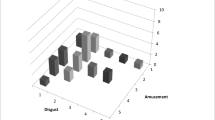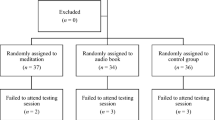Abstract
The mediation of superior coping with physical discomfort after humorous stimulation was explored through respondents' exposure to materials varying markedly in their capacity to evoke amusement and joviality. Both male and female respondents were exposed to (a) stand-up comedy, (b) situation comedy, (c) serious drama, (d) instructional material, or (e) tragedy. Discomfort threshold for cuff pressure at the upper arm was ascertained prior to and following exposure. Cognitive and affective responses to the materials were recorded after the postexposure threshold measurement. Compared against exposure to instructional material in the control condition, and compared against pre-exposure threshold measures, exposure to either type of comedy and, unexpectedly, to tragedy significantly elevated the threshold for physical discomfort in both male and female respondents. Serious drama had no such effect. Taken together, the exposure effects on the discomfort threshold could not be attributed to amusement reactions. Nor could they be considered mediated by responses of positive hedonic quality during and after exposure. There was some indication, however, that the capacity of stimuli to evoke humorous reactions (material being deemed funny) and the absorption potential of stimuli (material being deemed captivating) were positively involved in the mediation of postexposure tolerance of physical discomfort.
Similar content being viewed by others
References
Adams, E. R., & McGuire, F. A. (1986). Is laughter the best medicine? A study of the effects of humor on perceived pain and affect.Activities, Adaptation, and Aging, 8, 157–175.
Bailey, J. (1988, August). Rx: Laughter.McCalls, 115, pp. 106–107.
Berk, L. S., Tan, S. A., Fry, W. F., Napier, B. J., Lee, J. W., Hubbard, R. W., Lewis, J. W., & Eby, W. C. (1989). Neuroendocrine and stress hormone changes during mirthful laughter.American Journal of the Medical Sciences 298(6), 390–396.
Bradburn, N. M. (1969).The structure of psychological well-being. Chicago: Aldine.
Cantor, J. R., & Zillmann, D. (1973). Resentment toward victimized protagonists and severity of misfortunes they suffer as factors in humor appreciation.Journal of Experimental Research in Personality, 6, 321–329.
Carruthers, M., & Taggart, P. (1973). Vagotonicity of violence: Biochemical and cardiac responses to violent films and television programmes.British Medical Journal, 3, 384–389.
Cogan, R., Cogan, D., Waltz, W., & McCue, M. (1987). Effects of laughter and relaxation on discomfort thresholds.Journal of Behavioral Medicine 10(2), 139–144.
Cousins, N. (1979).Anatomy of an illness. New York: Bantam.
Cousins, N. (1989, October). Proving the power of laughter.Psychology Today, 23, pp. 22–26.
Cross, F., & Cross, W. (1977, November). Cheers, a belly laugh can help you stay well.Science Digest, 82, pp. 15–20.
Dillon, K. M., Minchoff, B., & Baker, K. H. (1985–1986). Positive emotional states and enhancement of the immune system.International Journal of Psychiatry in Medicine 15(1), 13–18.
Dixon, N. F. (1980). Humor: A cognitive alternative to stress? In I. G. Sarason & C. D. Spielberger (Eds.),Stress and anxiety (Vol. 7, pp. 281–289). Washington, DC: Hemisphere.
Eysenck, H. J., & Eysenck, S. B. G. (1976).Psychoticism as a dimension of personality. London: University of London Press.
Fry, W. F. (1979). Humor and the cardiovascular system. In H. Mindess & J. Turek (Eds.),The study of humor: Proceedings of the 2nd International Humor Conference (pp. 55–61). Los Angeles: Antioch College.
Gallo, N. (1989, August). Lighten up: Laugh your way to good health.Better Homes and Gardens, 67, pp. 31–32.
Goldstein, J. H. (1987). Therapeutic effects of laughter. In W. F. Fry & W. A. Salameh (Eds.),Handbook of humor and psychotherapy: Advances in the clinical use of humor (pp. 1–19). Sarasota, FL: Professional Resource Exchange.
Haig, R. A. (1988).The anatomy of humor: Biopsychosocial and therapeutic perspectives. Springfield, IL: Thomas.
Hyers, C. (1981).The comic vision and the Christian faith. New York: Pilgrim Press.
Joubert, L. (1979).Treatise on laughter (G. DeRocher, Trans.). Tuscaloosa, AL: University of Alabama Press. (Original work published in 1579)
Lefcourt, H. M., & Martin, R. A. (1986).Humor and life stress: Antidote to adversity. New York: Springer-Verlag.
Levi, L. (1965). The urinary output of adrenalin and noradrenalin during pleasant and unplesant emotional states: A preliminary report.Psychosomatic Medicine, 27, 80–85.
Long, P. (1987, October). Laugh and be well?Psychology Today, 21, pp. 28–29.
Martin, R. A., & Dobbin, J. P. (1988). Sense of humor, hassles, and immunoglobulin A: Evidence of a stress-moderating effect of humor.International Journal of Psychiatry in Medicine 18(2), 93–105.
Martin, R. A., & Lefcourt, H. M. (1983). Sense of humor as a moderator of the relation between stressors and moods.Journal of Personality and Social Psychology, 45, 1313–1324.
McCarthy, D. (1983, September). Warning: Humor could be hazardous to your illness.Saturday Evening Post, 255, pp. 30–31.
McDougall, W. (1922). A new theory of laughter.Psyche, 2, 292–303.
Moody, R. A. (1978).Laugh after laugh. Jacksonville, FL: Headwaters Press.
Nezu, A. M., Nezu, C. M., & Blissett, S. E. (1988). Sense of humor as a moderator of the relation between stressful events and psychological distress: A prospective analysis.Journal of Personality and Social Psychology, 54, 520–525.
Sully, J. (1902).Essays on laughter. New York: Longmans, Green.
Walsh, J. J. (1928).Laughter and health. New York: Appleton.
Weaver, J. (1991). Unpublished data, Auburn University, Auburn, AL.
Zillmann, D. (1983). Transfer of excitation in emotional behavior. In J. T. Cacioppo & R. E. Petty (Eds.),Social psychophysiology: A sourcebook (pp. 215–240). Nw York: Guilford Press.
Zillmann, D. (1991). Television viewing and physiological arousal. In J. Bryant & D. Zillmann (Eds.),Responding to the screen: Reception and reaction processes (pp. 103–133). Hillsdale, NJ: Erlbaum.
Author information
Authors and Affiliations
Additional information
The authors would like to thank Charles Aust, Rahul Biswas, Ted Jones, and John Owens for their assistance in the data collection and in the planning of this investigation.
Rights and permissions
About this article
Cite this article
Zillmann, D., Rockwell, S., Schweitzer, K. et al. Does humor facilitate coping with physical discomfort?. Motiv Emot 17, 1–21 (1993). https://doi.org/10.1007/BF00995204
Issue Date:
DOI: https://doi.org/10.1007/BF00995204




